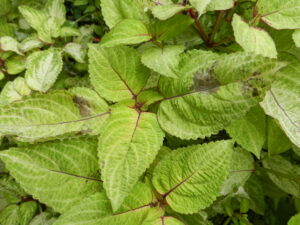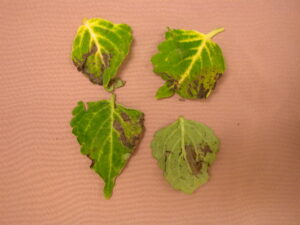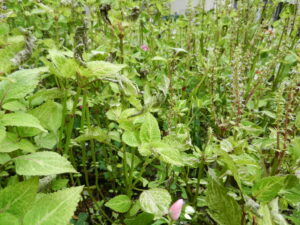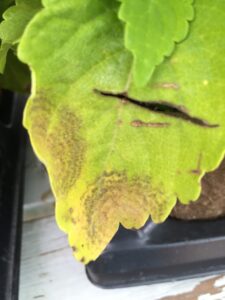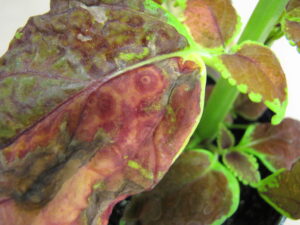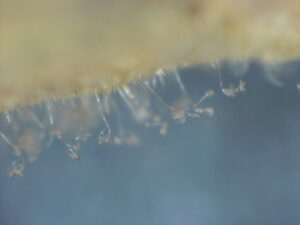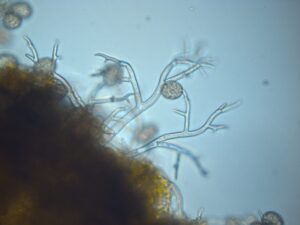First identified on coleus in the US in 2005, downy mildew has become an annual threat to production of this popular annual. The disease may be caused by the pathogens Peronospora lamii (also infects basil, as well as several species of Salvia and Lamium) or P. belbaharii (also infects basil). The symptoms may range from barely noticeable spots (Fig 1), to large blotches (Fig 2), to leaf distortion or defoliation of the entire plant (Fig 3). Cultivars show extensive variation in how they react to the fungus and symptoms may mimic Impatiens necrotic spot virus (INSV) (Fig 4 A and B), Botrytis blight, drought stress or spray burn. Spread is primarily by air-borne spores and cool conditions with high humidity favor spore production and infection. Spores are produced on the undersides of leaves (Figs. 5 and 6) and can resemble Botrytis sporulation unless viewed with a hand lens or microscope.
- Fig 1. Early stage of downy mildew leaf spot symptoms on coleus
- Fig 2. As downy mildew develops large areas of leaves may become necrotic.
- Fig 3. In high humidity conditions downy mildew may cause extensive defoliation
- Fig 4A. Downy mildew lesions showing concentric rings, a symptom often associated with virus disease
- Fig 4B. Coleus leaf with Impatiens necrotic spot virus showing concentric rings.
- Fig 5. Downy mildew spores are produced on the undersides of leaves, giving the leaf surface a fuzzy gray appearance.
- Fig 6. Microscope view of coleus downy mildew spores
Recommendations for greenhouse growers:
- Check incoming coleus and other host plants carefully for any signs of disease before placing them in the greenhouse.
- Reduce greenhouse humidity where possible to reduce spore production.
- Do not work with plants while they are wet or damp
- Confirm suspected downy mildew by sending samples for diagnosis to the Purdue Plant and Pest Diagnostic Lab
- Cover diseased plants in a plastic bag before removing them from the greenhouse to reduce spread of spores.
- Spray with an appropriate fungicide to protect uninfected plants before the problem appears.
For landscapers and gardeners:
- The disease is less likely to be a problem in the landscape than the greenhouse.
- Look for healthy transplants without leaf spots or distortion of the leaves.
- Water by trickle irrigation on the soil surface instead of using a sprinkler.
- Do not work with plants while they are wet or damp
- Bag and remove badly infected plants from the garden.
- Most fungicides used against this fungus are available only to professional applicators. For more information a list of fungicides labeled for use, see Janna Beckerman’s publication “Downy Mildew of Landscape Plants” at: http://www.extension.purdue.edu/extmedia/BP/BP-68-W.pdf
